Stripes are one of the most amazing and also unique features of animals. Just like humans with unique fingerprints, some striped animals, For example, tigers, with stripes are unique because of their pattern.
In this Article, We shall look at Animals with Stripes across the world including from the sea as well .
Let’s also know the roles that a stripe can play.
Table of Contents
Animals With Stripes:
Zebra

The Zebras, including the plains zebra, the mountain zebra, is a herbivorous mammal with striped coats that belongs to Genus Equus, Family Equidae, and is found in eastern and southern Africa, Ethiopia, Northern Kenya, Namibia, and Angola.
It’s easy to recognize them because of their black and white stripes. Generally, this stripe pattern is present on the dorsal surface that stretches from head to tail and also to other parts of its body. Those stripes located on the ears, legs, and tails are separate, especially, the stripes on the eyes and lower jaw have complex patterns. Surprisingly, Its stripes play many roles, It can act as sunscreen against the sunlight, discouraging and unattractive to the disease spreading bloodsucking horseflies.
The interesting fact about its stripes is they are unique to each individual zebra. As there is no possibility of two humans having the same fingerprints, similarly there are no two zebras that could have the same stripes by location, thickness, length, and darkness.
Bongo

The bongo, including Lowland bongo, Mountain bongo, is herbivorous antelope with a nocturnal tendency that belongs to Genus Tragelaphus, Family Bovidae and is found in Africa and other places.
Bongos is the third-largest antelope in the world and both sexes of these species have stripes. They have as many as 10-15 white stripes on their body that is located on the chestnut-brown colored coat. We can see bristly dorsal hair that is short, bristly originating from the shoulder to the rump.
Its bright white stripes on the chestnut-brown colored coat help them to camouflage with their background habitats.
Okapi
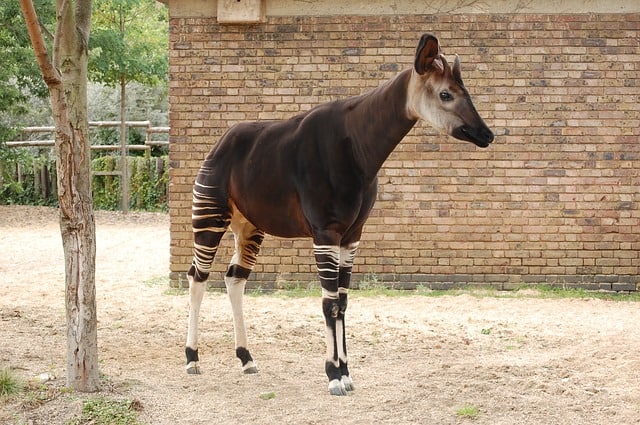
The okapi, also known as the forest giraffe, Congolese giraffe, and zebra giraffe, is an herbivorous mammal that belongs to Genus Okapia, Family Giraffidae, and is found in the Democratic Republic of Congo, Africa, and other places.
Most confuse the Okapi as a relative of Zebra because its stripes present on the back are similar to those of Zebra. However, Okapi is actually related to the giraffe, So It is named a forest giraffe, Congolese giraffe. They have a chocolate-reddish brown coat with white horizontal stripes located on the back, rings of white stripes on their legs, and white fur on ankles.
These combinations of white stripes on the chocolate-reddish brown coat enable camouflage features in the middle of the dense vegetation. Some people expect these stripes to help the young okapi to find and follow their mother in the dense rainforest.
Greater Kudu
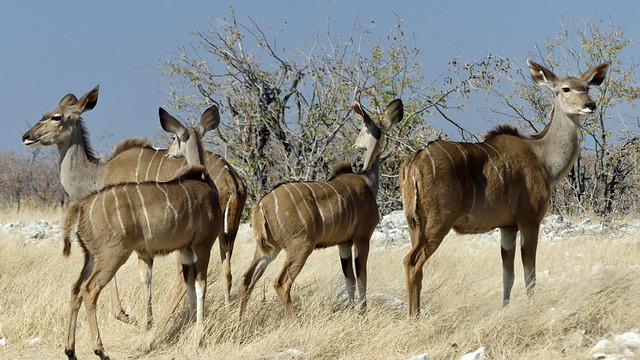
The greater kudu is an antelope that belongs to Genus Tragelaphus, Family Bovidae, and is found in Eastern Africa, southern Africa, Ethiopia, and other places.
They have a brown-reddish coat with as many as 12 vertical white stripes on their torso. Its head has darker colored coats than the rest of the body with a small chevron that is white in color stretches around their eyes.
Surprisingly, The greater kudu’s brown coat with white stripes helps to camouflage them in their environments.
Zorse
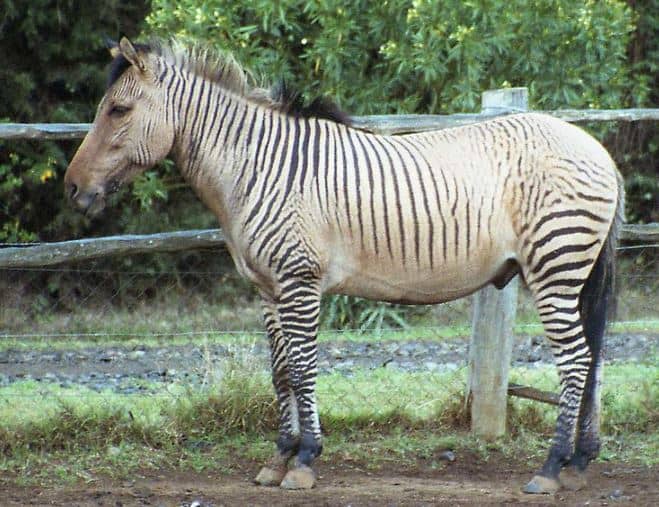
A zorse is a young produced by crossing a zebra with any equine that belongs to Genus Equus, Family Equidae, and is found in open grassland, woodlands of Africa, zoos, and other places.
They have white patches and striped patches that are inherited from their parents, depending on whether the male is the horse with a female zebra and vice versa.
Zorse can have a short, coarse fur that varies color by white, tan, grey, red, brown, or black, along with stripes of zebra on their legs and rump.
Tiger
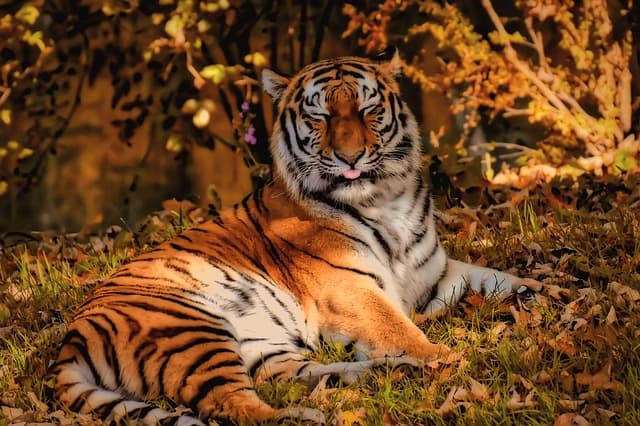
The tiger is a large-sized carnivorous mammal that belongs to Genus Panthera, Family Felidae, and is found in Russia, China, India, Bangladesh, Nepal, Bhutan, Myanmar, Laos, Cambodia, Vietnam, Malaysia, and Indonesia.
They have a brown- white colored coat with black colored vertical stripes on them. These combinations of stripes and patterns are unique to each individual of tigers. Its coat is thinner with shorter fur and has a soft layer of fur cushion to keep them warm.
Its black stripes and brown fur imitate the falling sunlight in the forest through the trees as it helps them to camouflage with filtered sunlight and the shadow of trees that can’t be easily recognizable by their prey.
Striped Hyena
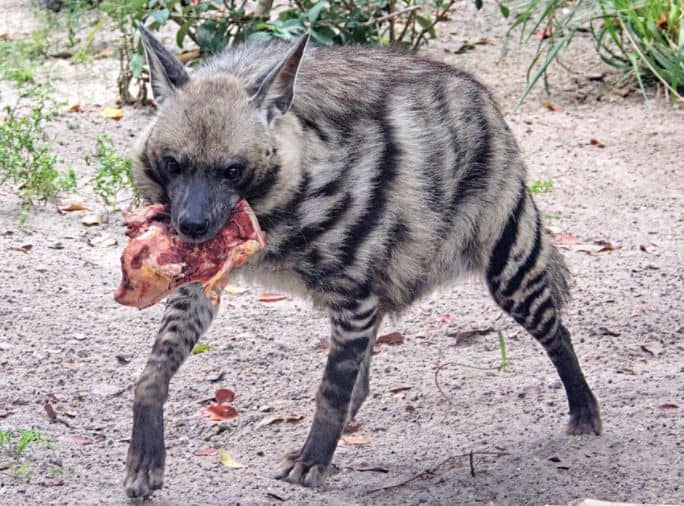
The striped hyena is a hyena species that belongs to Genus Hyaena, Family Hyaenidae, and is found in North and East Africa, the Caucasus, Asia, and India.
They have a dirty grey color coat with dark vertical stripes and many spots of variable sizes on their bodies. Fortunately, Its winter coat has longer and uniform hair than those present in the summer period. This winter coat has a denser, and softer underfur that keeps them warm.
Surprisingly, Its fur lacks underfur that presents in the winter to keep them warm which is a good adaptation for the hot summer climate.
African Wild Ass
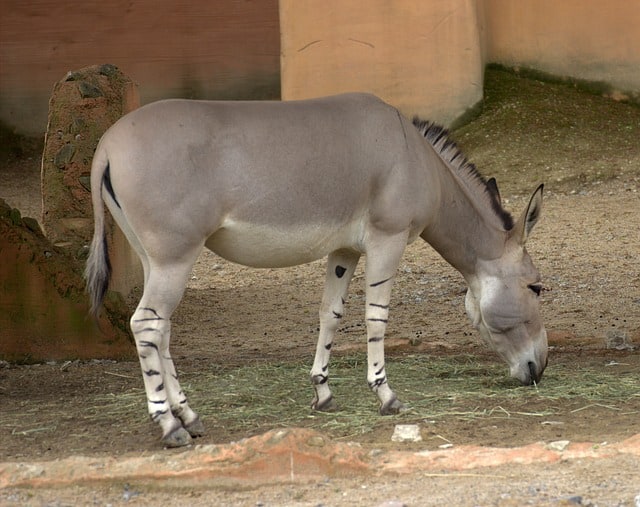
The African wild ass, also known as the African wild donkey, is a wild ass that belongs to Family Equidae, Genus Equus, and is found in the Horn of Africa, Eritrea, Somalia, and Ethiopia.
They have a light-brown colored coat all over the body with black and horizontal stripes on all the limbs. There is also a stripe of fur located across the shoulder.
Interestingly, Its horizontal stripes present on its legs resembles those stripes on the legs of the zebra.
Numbat

The numbat, also known as the walpurti, the Banded Anteater, is an insectivorous animal that belongs to Genus Myrmecobius, Family Myrmecobiidae, and is found in Western Australia, and other places.
They have reddish-brown fur with a black stripe that helps them to camouflage in their habitats, especially in its woodland floor.
Its upper body surfaces have a band of black fur that is vertical in shape along with light stripes that run parallel to them. These stripes are more bright on the backside of the body and gradually turn lighter in color as it approaches the head and finally disappears.
Its main predators are birds, snakes, and other animals find difficulty to recognize these numbats because of its combinations of the coat with black stripes on it.
Striped Skunk
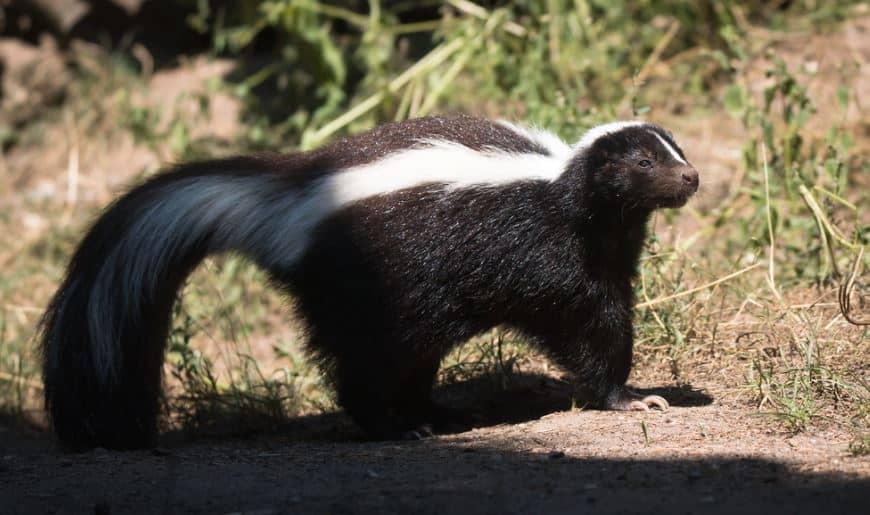
A striped skunk is a skunk species that belongs to Family Mephitidae, Genus Mephitis, and is found in central Canada, southern Canada, northern Mexico, and North America.
They have black fur all over the body with white striped fur. This white stripe starts on their head and diverges into two parallel stripes that stretch to the tail. This extension of two white-colored stripes from the head to tail is parallel to one another and also to their bodies.
Interestingly, the Striped skunk has a white-colored unique stripe on its head, a thin and long stripe, that extends from the top of the nose to the head while passing through the eyes.
Read More : Animals With Tusks !
Juvenile Tapir
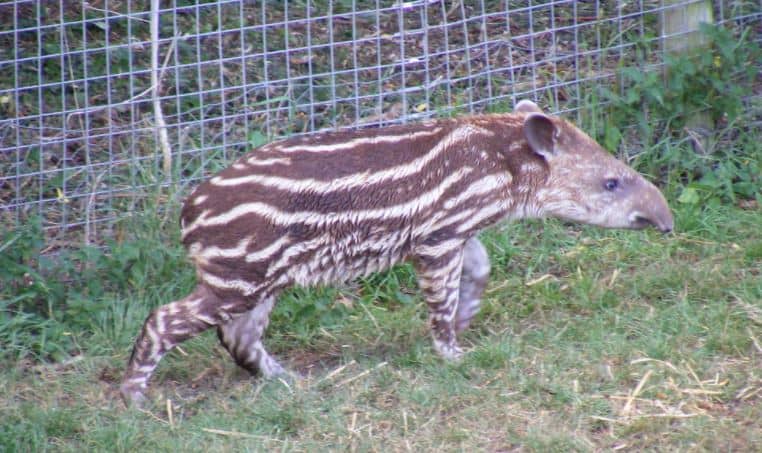
A tapir, including Mountain tapir, Malayan tapir, is a herbivorous animal that belongs to Family Tapiridae, Order Perissodactyla, and is found in South and Central America, Southeast Asia, Mexico, Brazil, Paraguay, Thailand, Malaya, and Sumatra.
Adults have a reddish-brown colored coat that has short fur but without striped fur and if it’s present it will be small in size. However, We can see a prominent stripe in the juveniles of the tapir in relation to adult tapirs. A juvenile tapir has a dark brown colored coat all over the body with a white stripe that is distributed horizontally all over their bodies along with white spots of fur.
Interestingly, The spots with horizontal stripes in the juvenile tapirs help them in camouflage in their environments.
Aardwolf

An aardwolf is a nocturnal mammal that belongs to Genus Proteles, Family Hyaenidae, and is found in South Africa, East Africa, and other places.
This insectivorous animal is often confused with striped hyena even though it is not a striped hyena. The aardwolf is a small mammal that possesses a coat of brown-yellowish fur with black stripes in a vertical position. There are about 5-7 black stripes present on the back and lateral surface of the body which continues to cover the legs at the end of their back.
These combinations of the dirty yellowish coat with black stripes on the body as well as on the legs help to camouflage with its environments.
Eastern Chipmunk
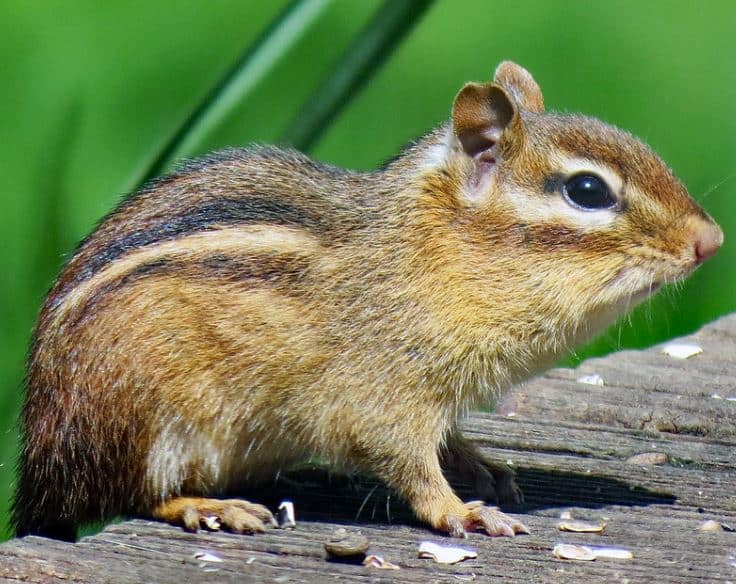
An eastern chipmunk is a species of a chipmunk that belongs to Genus Tamias, Family Sciuridae, and is found in eastern North America, Southern Canada, and Mexico.
They have reddish-brown fur on their upper body and lighter fur on the lower part of their body. On the back, there are about five dark brown colored horizontal stripes that are alternated with light brown colored stripes and all of these stripes end at the tail.
The chipmunk look like a squirrel but are not so because most squirrels don’t have stripes, and If any stripes are present in the squirrels then they are not comparable to the stripes in chipmunk in numbers
Grandidier’s Mongoose
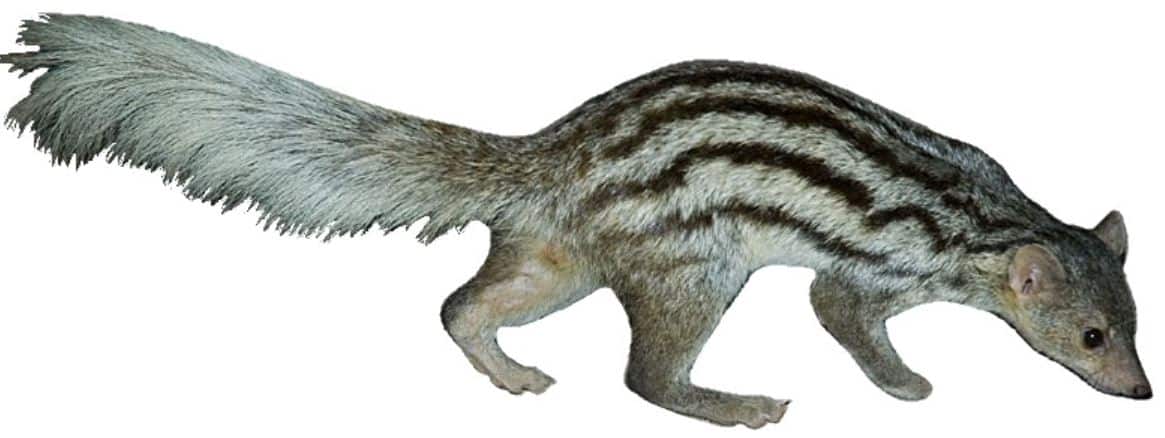
A Grandidier’s mongoose, also known as the giant-striped mongoose, and Grandidier’s vontsira, is a small-sized carnivorous mongoose that belongs to Genus Galidictis, Family Eupleridae, and is found in Madagascar, and other places.
They have a light brown-grayish colored coat with as many as eight dark-colored stripes on its back and side of the body. These black stripes are horizontal in position to their body and alternate with the white horizontal stripes. These white and black stripes end at the rump of their body where their tail starts to have a white-colored bushy tail.
Surprisingly, These combinations of yellow fur with black stripes help to camouflage themselves in their habitats effectively.
Clownfish
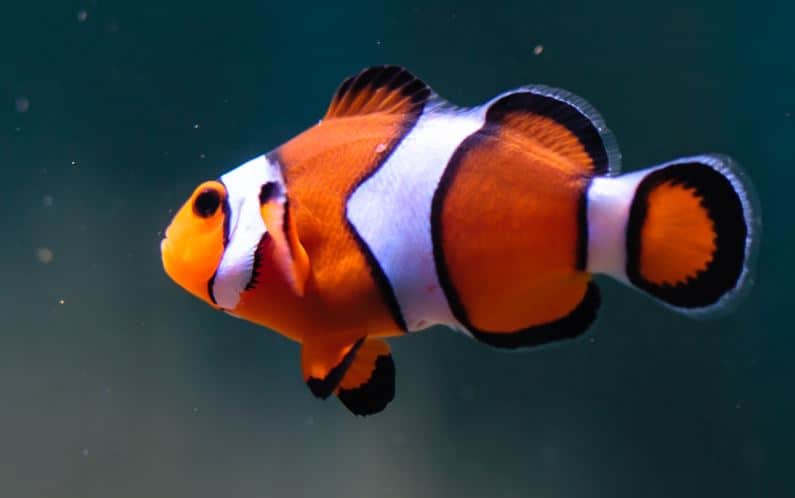
The clownfish is a colorful fish that belongs to Genus Amphiprion, Family Pomacentridae, and is found in the Red Sea, Pacific Oceans, lagoons, and around the anemone.
They have an orange-reddish-colored body with prominent three white colored vertical stripes covering its body. The first white vertical stripe is just after the eyes, the second is in the middle of the body, and the third white color stripe is at the tail.
Interestingly, These combinations of the orange body with white stripe and black line makes them so beautiful and helps them to camouflage themselves under the sea anemone.
Four Stripe Damselfish

A four stripe damselfish, also known commonly as blacktail dascyllus, humbug damselfish, blacktail damselfish, and blacktail humbug, is a fish that belongs to Genus Dascyllus, Family Pomacentridae, and is found in Indonesia, Philippines, and New Guinea.
These are black and white striped fish. There are about four white-colored stripes in a vertical position, the first white stripe starts with a mouth, the second is just behind the eyes of the fish, the third is located in the middle of its body, and the fourth stripe is the last stripe located on the tail. There are about three black stripes present between these white stripes along with one extra on the caudal fins.
The black and white stripes help to camouflage them in the fallen shadows of the sunlight that are dark and light.
Indian palm squirrel
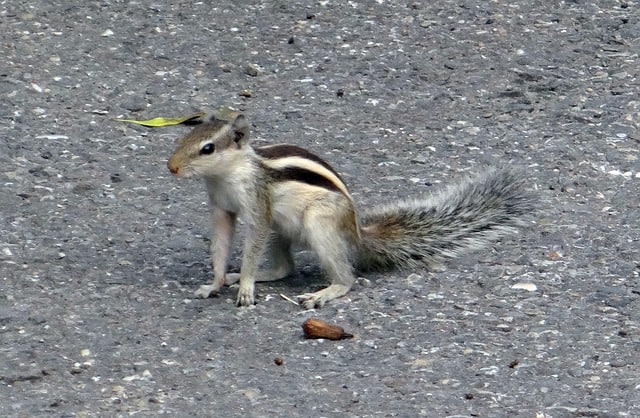
An Indian palm squirrel, also known as the three-striped palm squirrel is a rodent species that belongs to Genus Funambulus, Family Sciuridae, and is found in India, Sri Lanka, and other places.
They have grey-brown color fur with three bright white stripes on their back extending from the head to tails. These white stripes are between the dark olive-brown color stripes. Those lateral stripes on their body are present only between the fore and hind limbs. Whereas the ventral surface is covered by cream colored fur and the bushy tail is with long and white-grey hairs.
An interesting fact about these white stripes is, they are believed to be the marks of the fingers of Lord Rama.
Moorish idol
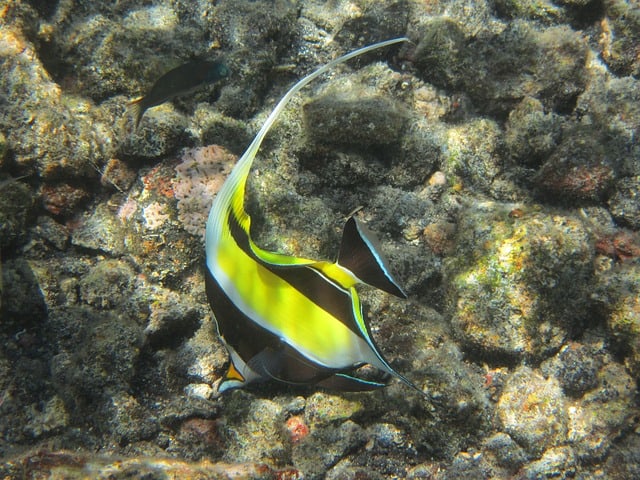
The Moorish idol is a marine fish that belongs to Genus Zanclus, Family Zanclidae, and is found in the Oceans of Africa, coral reefs of the Indian and Pacific Oceans, and other parts of the world.
They have black, white, and yellow stripes making them look beautiful. Among these stripes, There are 2-3 yellow vertical stripes that are alternated with the 3-4 black vertical stripes along with the thin white color of stripes between these stripes. Its small and sharp mouth resembles the beaks. Unfortunately, these fishes have a short lifespan.
Surprisingly, In Africa, These fishes are believed to be a bringer of happiness.
